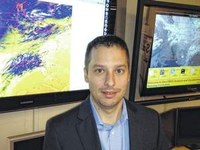Wyoming Valley native Michael Pavolonis to be honored for meteorological expertise
The National Oceanic and Atmospheric Administration’s (NOAA) Satellite and Information Service is honoring the Luzerne native for developing cutting-edge methods to convert satellite data into actionable information for mitigating hazards caused by volcanic eruptions. These new techniques improve the timeliness and accuracy of severe weather warnings.
Pavolonis’ inspiration came from his upbringing in Northeastern Pennsylvania during which he experienced two “monster storms” both 1991 and 1993 while a student at Bishop O’Reilly.
“Those storms had major impact and I was intrigued to learn how they were formed,” said Pavolonis.
The organization’s mission goes beyond just simply refining weather prediction techniques, it utilizes its findings to “protect lives and livelihoods,” enriching life through science.
In describing its work, its website says, “Our reach goes from the surface of the sun to the depths of the ocean floor as we work to keep citizens informed of the changing environment around them.”
NOAA’s scientists use cutting-edge research and high-tech instrumentation to provide citizens, planners, emergency managers and other decision makers with reliable information they need when they need it.
“The Johnson Award spotlights exemplary work young scientists like Mike are performing with satellite data that help save lives, protect the economy and benefit society overall, “said Stephen Votz, assistant administrator for NOAA’s satellite and information service.
“Having this research recognized for its potential to improve severe weather forecasts and improve aviation safety in the wake of volcanic eruptions means a great deal to me and serves as inspiration to continue to push the envelope in the endeavor of using science to transform satellite measurements into actionable information,” he said.
A graduate of Pennsylvania State University and the University of Wisconsin, Pavolonis had opportunity to address the United States House and Senate in 2014 on the importance of satellites in mitigating volcanic hazards.
When Pavolonis isn’t spending his time developing new technology for storm tracking, he is a prolific writer, having contributed 32 scientific papers ranging from volcanic ash and dust clouds to forecasting ash plumes.
The son of Carolyn Reino, Luzerne, and Robert Pavolonis, Wyoming, Pavolonis now resides in Wisconsin with his wife Melanie and daughter Ella.

